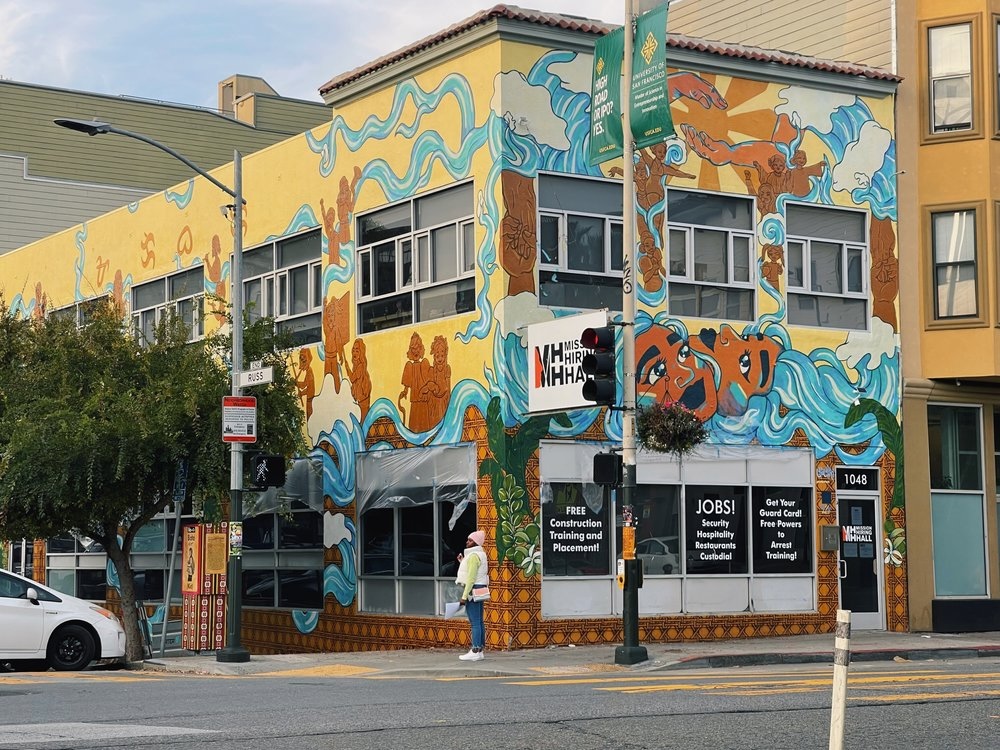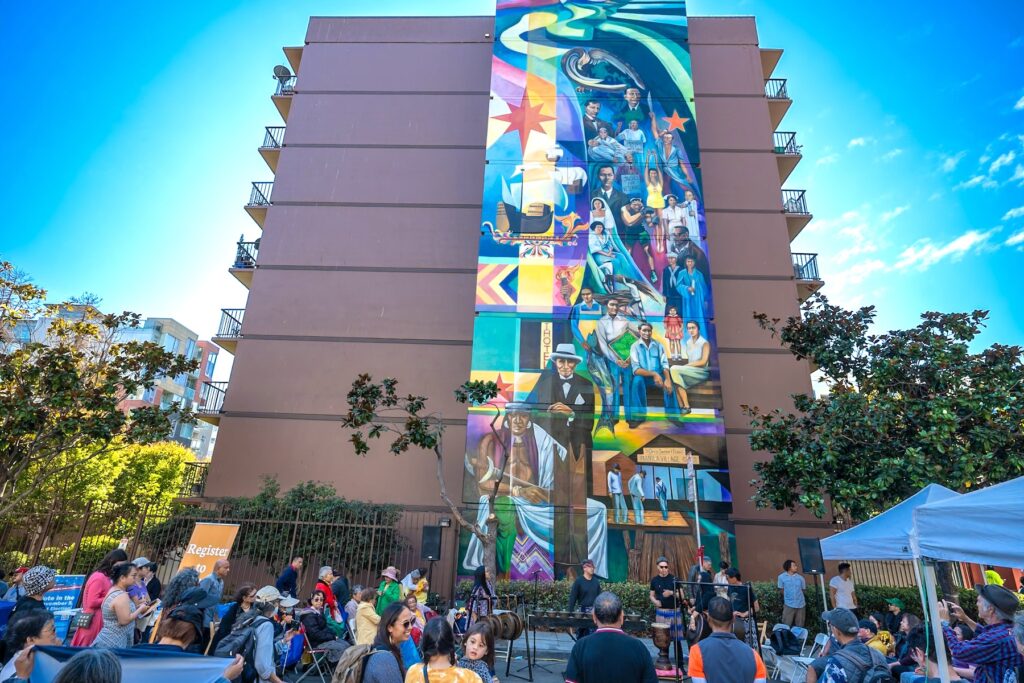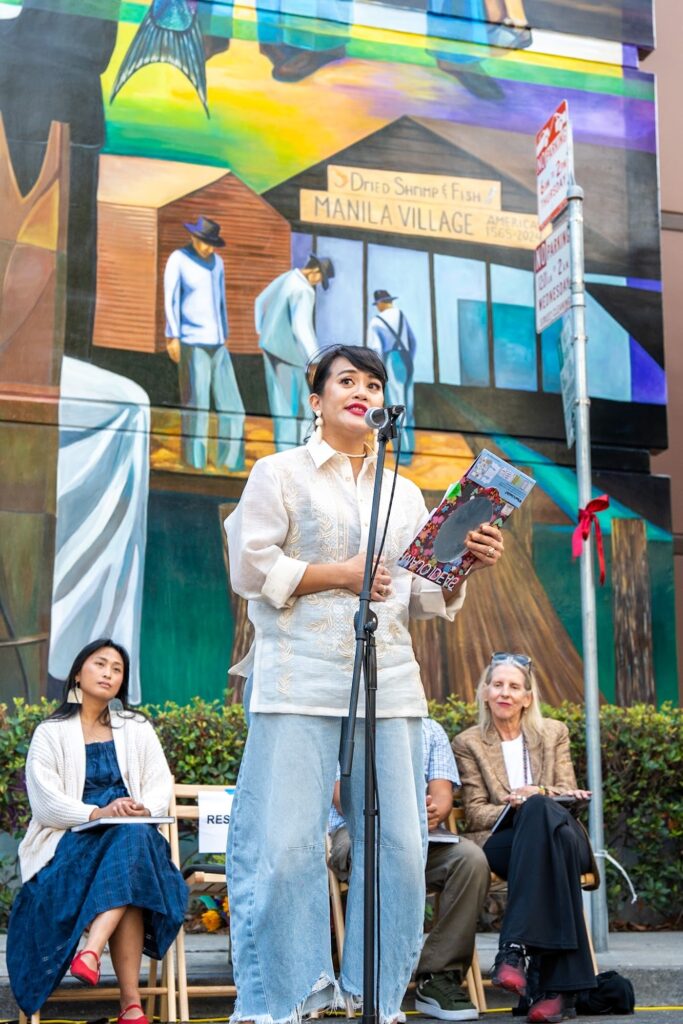In the past year, Filipino Heritage Cultural District SOMA Pilipinas has fostered a dozen public artworks onto the San Francisco landscape.
“Prior to this year, a lot of our cultural markers were temporary,” said Christine Abiba, the arts administrator for the organization. “And many of the monuments still document or even glorify the US occupation of the Philippines. So, there’s still very few markers, murals, public artworks, that really reflect our history. But this has been really momentous.”

The organization has released a live Google map so people can easily find the artworks in the district. Sitting in the lobby of the Yerba Buena Center for the Arts, right outside the SOMA Pilipinas office, Abiba showed some photos of some of them, such as Harvested Hopes, by Venazir Martinez.
“It shows kind of the tapestry of migrant work, different people who have migrated here and really contribute a lot to our economic workforce. You’ll see the water pump or the bomba, that really symbolizes how folks access water and find community there. But also, you’ll see like a man selling taho [a Filipino dessert].
Abiba points out a mural by ChiChai Mateo, Pagsasama–Sama (Joining Together in Tagalog).
“This mural really focuses on the different Pinay, the different women, who really are the backbone of our cultural district,” Abiba said. “You’ll see two diosas—maybe the nearest translation is goddesses or spirits—that give power to all the Pinays who are represented here.”

Mateo was a teaching artist at Bessie Carmichael Elementary School in the neighborhood, Abiba says, and the mural is right by the school, as well as the violence prevention organization United Playaz and the West Bay Pilipino Multi-Service Center.
“It’s important that as students enter through this walkway, the mural art around them reflects our stories and our history,” Abiba said.
At a community celebration on October 13, SOMA Pilipinas also unveiled the restored “Ang Lipi ni Lapu Lapu,” or “The Descendants of Lapu Lapu,” mural, painted by Johanna Poethig in 1984 on the wall of the San Lorenzo Ruiz Center.
Faded by 40 years of rain and sun, the figures in this mural including the Filipino boxer Pancho Villa; Larry Itliong, co-founder the United Farm Workers; Manong Benny, a resident of the low-income International Hotel; and Carlos Bulosan, author of America Is In the Heart, are now bright and clear once again.
Artists Mariel Paat and Dev Heyrana assisted Poethig with the mural’s restoration.

Heyrana says she had never worked on anything this big—the mural is 90 feet tall—but she wanted the challenge. Seeing her history represented in the mural meant a lot to her when she first saw it after moving to San Francisco in her 20s. Heyrana’s family immigrated to Washington DC when she was nine years old, right before wintertime, and she found both the weather and the attitude cold.
“I think a lot of my growing up here in the US was really defined by not seeing myself present,” she said. “I grew up represented everywhere, and then I moved to the United States where I didn’t see myself.”
Heyrana is glad to that her daughters, who are 11 and seven, can see their history represented in the mural and other art in the neighborhood.

A competitive swimmer and diver growing up, Heyrana immediately recognized diver Victoria Manalo Draves in the mural. Draves grew up in the neighborhood, where there’s now a park named after her. At the 1948 Summer Olympics in London, she became the first Asian American Olympic gold medalist as well as the first American woman to win two gold medals in diving.
A few blocks away, at the San Francisco Museum of Modern Art, there’s a new mural dedicated to Draves. Jenifer K. Wofford’s VMD, is part of the museum’s Bay Area Walls (along with David Huffman and Gene Leun Yang) for SFMOMA’s Get in the Game exhibition about sports and culture.
Wofford had a couple of grants to work on a piece about Draves. SFMOMA curator Tanya Zimbardo saw some of the prints Wofford had done and asked her to create the mural.

Draves’s story is well known to Wofford. Her mother was white and her father Filipino, and she couldn’t swim in the Fairmont Swimming and Diving Club (now the Tonga Room) with his name. Instead, she had to use her mother’s maiden name and swim as Vicki Taylor.
Wofford thought careful about how she depicted Draves in the mural.
“I didn’t go with what she’s most famous for, which is the swan dive. It’s a very showboating kind of dive,” Wofford said. “I chose to do a reverse pike where she’s actually tucking into herself, kind of closing herself off, and she’s got her eyes closed. And that was really important for me to have her kind of between worlds.”
Wofford, who is close with Poethig, points out that, as well as famous people, her mural honors nurses and laborers.
The restoration of the mural and all the new public art in the district is wonderful to see, Wofford says. Heyrana agrees, adding she’s particularly glad people in the community made the art. At the October 13 celebration of the mural, she noticed the difference that made.
“You’re building generational awareness and love for the creative community. I was looking at the kids and watching them see what was happening,” she said. “I like to see that ladder just keep going up and up and up and raising them in a way. It’s just so much deeper for me when a community invests in the people who actually live in it.”
Wofford got emotional with the installation of the mural of Draves in SFMOMA.
“It feels like she’s come home in a way,” she said. “She’s in Johanna’s mural, she has a park named after her, but to have her so prominently placed, at this balcony, visible from the atrium floor feels like Filipino American history is finally visible. It’s no longer on the shadows of the margins. It’s front and center.”





